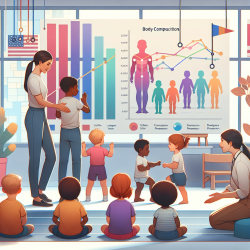Introduction
As a speech-language pathologist deeply committed to improving outcomes for children, it is crucial to explore how interdisciplinary research can inform our practice. A recent study titled Differences in Body Composition across Police Occupations and Moderation Effects of Leisure Time Physical Activity offers valuable insights that can be adapted to enhance child therapy outcomes. This research highlights the relationship between body composition and physical activity, providing a framework that can be applied to speech and language therapy for children.
Understanding the Research
The study examined body composition differences among police officers in various occupations and how leisure time physical activity (LTPA) moderated these differences. Officers in more physically demanding roles exhibited lower body fat and higher skeletal muscle mass, suggesting that physical activity significantly influences body composition. This finding underscores the potential of integrating physical activity into therapeutic practices to optimize health and developmental outcomes.
Application to Child Therapy
Speech-language pathologists can draw parallels between the physical demands of police work and the developmental needs of children. Incorporating physical activity into therapy sessions can enhance cognitive and communicative abilities, much like how physical fitness supports occupational performance in police officers. Here are some practical ways to implement these insights:
- Incorporate Movement-Based Activities: Design therapy sessions that include movement-based activities to engage children physically and mentally. Activities such as obstacle courses, dance, or yoga can be tailored to target specific speech and language goals.
- Use Play as a Therapeutic Tool: Integrate play-based interventions that encourage physical activity, such as role-playing games or storytelling with actions. These activities can improve language skills while promoting physical health.
- Collaborate with Physical Therapists: Work closely with physical therapists to develop comprehensive intervention plans that address both communication and physical development needs.
Encouraging Further Research
While the study on police officers provides a foundational understanding, further research is needed to explore the specific impacts of physical activity on speech and language development in children. Practitioners are encouraged to conduct studies that investigate the benefits of integrating physical activities into therapy sessions, examining outcomes such as improved articulation, language comprehension, and social interaction skills.
Conclusion
By leveraging interdisciplinary research, speech-language pathologists can enhance their practice and create better outcomes for children. The integration of physical activity into therapy sessions is a promising approach that aligns with data-driven decision-making and evidence-based practices. For those interested in delving deeper into the original research, please follow this link: Differences in Body Composition across Police Occupations and Moderation Effects of Leisure Time Physical Activity.










